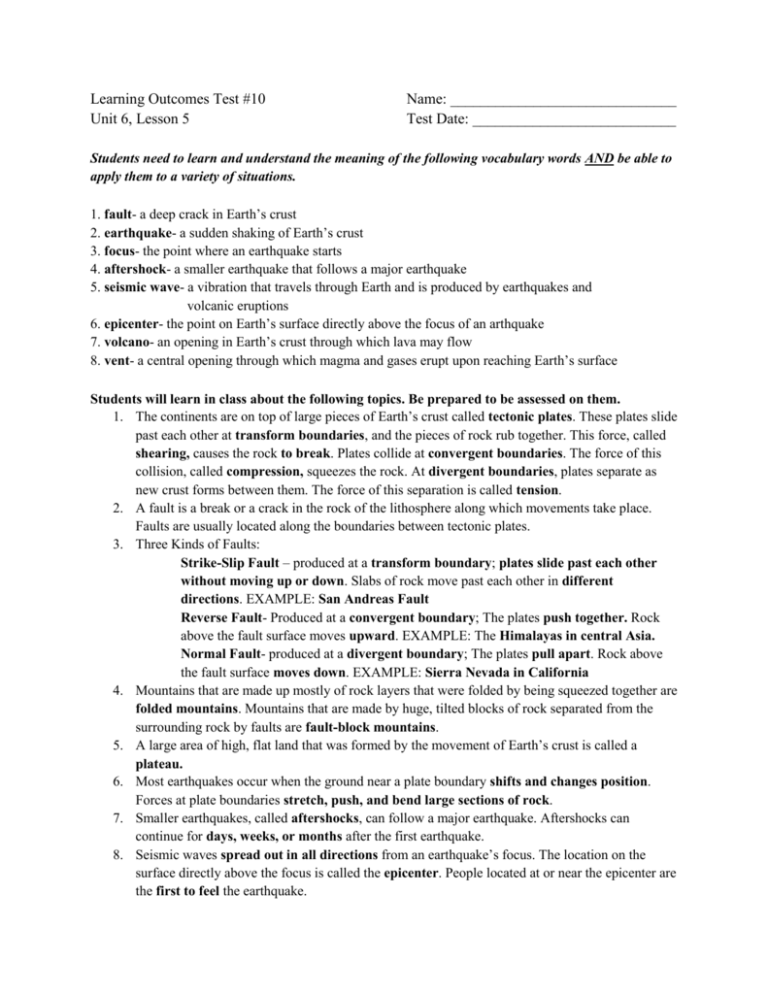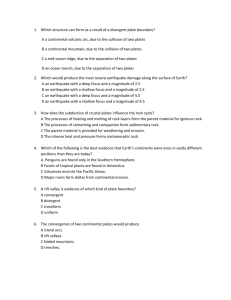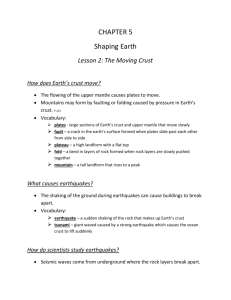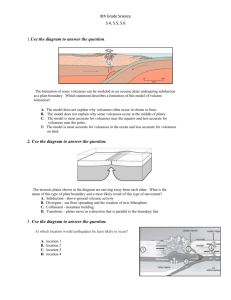Learning Outcomes Test #10 Name: Unit 6, Lesson 5 Test Date
advertisement

Learning Outcomes Test #10 Unit 6, Lesson 5 Name: ______________________________ Test Date: ___________________________ Students need to learn and understand the meaning of the following vocabulary words AND be able to apply them to a variety of situations. 1. fault- a deep crack in Earth’s crust 2. earthquake- a sudden shaking of Earth’s crust 3. focus- the point where an earthquake starts 4. aftershock- a smaller earthquake that follows a major earthquake 5. seismic wave- a vibration that travels through Earth and is produced by earthquakes and volcanic eruptions 6. epicenter- the point on Earth’s surface directly above the focus of an arthquake 7. volcano- an opening in Earth’s crust through which lava may flow 8. vent- a central opening through which magma and gases erupt upon reaching Earth’s surface Students will learn in class about the following topics. Be prepared to be assessed on them. 1. The continents are on top of large pieces of Earth’s crust called tectonic plates. These plates slide past each other at transform boundaries, and the pieces of rock rub together. This force, called shearing, causes the rock to break. Plates collide at convergent boundaries. The force of this collision, called compression, squeezes the rock. At divergent boundaries, plates separate as new crust forms between them. The force of this separation is called tension. 2. A fault is a break or a crack in the rock of the lithosphere along which movements take place. Faults are usually located along the boundaries between tectonic plates. 3. Three Kinds of Faults: Strike-Slip Fault – produced at a transform boundary; plates slide past each other without moving up or down. Slabs of rock move past each other in different directions. EXAMPLE: San Andreas Fault Reverse Fault- Produced at a convergent boundary; The plates push together. Rock above the fault surface moves upward. EXAMPLE: The Himalayas in central Asia. Normal Fault- produced at a divergent boundary; The plates pull apart. Rock above the fault surface moves down. EXAMPLE: Sierra Nevada in California 4. Mountains that are made up mostly of rock layers that were folded by being squeezed together are folded mountains. Mountains that are made by huge, tilted blocks of rock separated from the surrounding rock by faults are fault-block mountains. 5. A large area of high, flat land that was formed by the movement of Earth’s crust is called a plateau. 6. Most earthquakes occur when the ground near a plate boundary shifts and changes position. Forces at plate boundaries stretch, push, and bend large sections of rock. 7. Smaller earthquakes, called aftershocks, can follow a major earthquake. Aftershocks can continue for days, weeks, or months after the first earthquake. 8. Seismic waves spread out in all directions from an earthquake’s focus. The location on the surface directly above the focus is called the epicenter. People located at or near the epicenter are the first to feel the earthquake. 9. Magnitude is the measure of the energy released during an earthquake. 10. Two Measures of earthquakes: The Richter Scale: set of numbers used to describe an earthquake’s magnitude on a scale of 1 to 10. An increase of 1 on the Richter scale means a tenfold increase in an earthquake’s magnitude. This means a 2 on the scale is 10 times stronger than a 1. The strength of an earthquake can also be measured by its intensity, or the strength as it felt on earth’s surface. The Mercalli Scale rates what people near the epicenter feel and observe when an earthquake occurs. The Richter scale measures magnitude; the Mercalli scale measures intensity. 11. The Richter scale is more reliable than the Mercalli scale. 12. A tsunami is a series of huge waves caused by an earthquake or a volcanic eruption beneath the ocean floor. 13. Water in a tsunami moves away from the epicenter of the earthquake in all directions. Tsunamis have long wavelengths and low amplitudes, or wave heights. The speed of the tsunami depends on the depth of the water. 14. Given Summaries of the Mercalli and Richter Scales, classify how strong the earthquake is in magnitude and intensity. (p. 351 in text- Example: Infer Question)) 15. Why does a tsunami become taller when it approaches a shore? A tsunami’s energy is related to its speed and wave height. In deep water, a tsunami moves quickly with short waves. Near a coast, the tsunami slows down because the water is shallower. Because its energy doesn’t change, as the speed decreases, the height must increase. 16. Volcanoes are vents in Earth’s crust through which magma, gases, and other materials are forced out. Magma chambers are the reservoirs from which volcanic materials erupt. When magma reaches the surface, it erupts through a central opening called a vent. Once magma reaches the surface, it is called lava. A crater is the space around the vent at the top of a volcano. 17. Three main kinds of landforms are produced by volcanic eruptions. Cinder cone volcanoes are mainly made up of small rock particles, or cinders. Cinder cone volcanoes are cone-shaped with steep sides. Shield volcanoes are made up of many layers of rock. They are broad with gently sloping sides that resemble a shield carried by ancient warriors. Composite volcanoes are made up of layers of thick lava alternating with layers of ash, cinders, and rocks. These layers form a symmetrical cone with steep sides that are concave, or curving inward. 18. Sometimes, a volcano’s crater collapses into the vent. This forms a wide crater called a caldera. 19. Volcanoes that have erupted recently are called active. Volcanoes that have not erupted in a long time, but have erupted in recorded history are called dormant, or sleeping. If a volcano has never been observed erupting, it is said to be extinct. 20. Volcanoes differ in the kinds of materials they eject, in the intensity and frequency of eruptions, and in the types of landforms that result. 21. A string of island volcanoes, or an island arc, can form where one oceanic plate is driven under another. Where plates move apart, volcanoes can form at the gaps along the plates’ edges. These volcanic landforms are called rift volcanoes. 22. The largest and deepest magma formation is a batholith. Batholiths are large pockets of magma that reach deep into the crust. 23. What do earthquakes, volcanic eruptions, and tsunamis have in common? All three are natural events that can cause great destruction. All three are caused by movements of tectonic plates.







